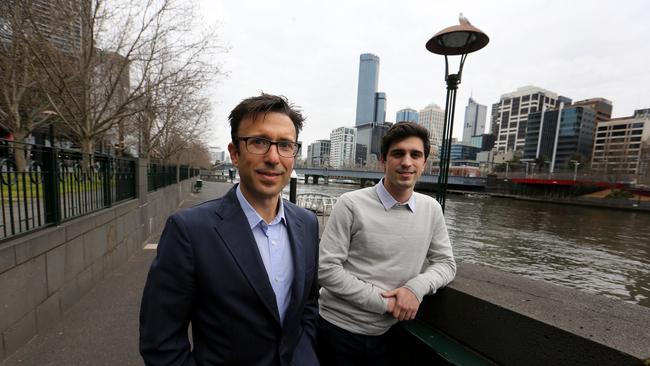Afterpay enjoys virtuous circle

The more partnerships they strike with merchants, the more that hard-to-reach millennial customers join their buy now, pay later platform, and the more that merchants jump on board for the ride. Mind you, the founders aren’t complaining.
Sure, they’ve got a pesky Austrac to deal with, but each time they enter a new country it takes less time than the previous one to reach the same milestones. It took almost three years to achieve $1 billion in underlying sales in Australia and New Zealand, but only 14 months starting from scratch in the US. The current run-rate in the US is $1.7bn.
The same magic juice is working in Britain, despite trading under a different name, Clearpay, due to a trademark dispute.
In its first 15 weeks since launch, Clearpay has clocked up more than 200,000 active customers — ahead of the US over the same period. The massive size of the US market compared with Australia is obviously a consideration, but the addressable market in the UK is much smaller than the US.
It’s quite possible that Eisen and Molnar are getting better at what they do and benefiting from network effects, as they leverage merchant partnerships established in one country when they move into another. One example is the UK-based online fashion retailer boohoo.com, which caters for Afterpay’s core market of 16-30 year-olds. The Afterpay virtuous circle, which Eisen calls a “flywheel”, has a few more component parts than meets the eye.
A productive retail partnership leads to endorsements of the platform by the retailer, which might have millions of Facebook followers. Another flywheel is the process of scaling the platform. The larger the network, the longer that customers stay on the platform and engage in repeat purchases. Loss rates correspondingly fall.
Unlike rivals such as Zip Co, Afterpay’s revenue overwhelmingly comes from merchants. Merchant fees charged by Swedish group Klarna, which has partnered with the Commonwealth Bank in Australia, are much lower.
Afterpay said yesterday it had experienced no downward pressure on merchant fees.
The imperative for Afterpay is to keep its merchants on-side with compelling data insights.
Eisen says the company is a retail distribution channel to the hard-to-crack but keenly sought millennial market, offering more leads to its merchants than anyone bar Google. This enables merchants to spend their marketing dollars with greater precision.
Judo hold on equity
If Joseph Healy’s challenger bank Judo achieves nothing else, it will at least be remembered for raising $540 million of equity in less than a year — the largest amount of private investment raised by an Australian start-up.
The founder seems to be in a league of his own when it comes to bending the ear and tickling the hip-pocket nerve of global investors. Content, however, is just as important, which is why the slide-deck for Healy’s current investor roadshow is an important insight into Healy’s view of SME banking in Australia.
The presentation, obtained by Four Pillars, starts with the market opportunity. Despite repeated attempts to shake their dominance, the four big banks still control 85 per cent of the total banking market, with a profit share equivalent to 2.9 per cent of GDP compared with 1.2 per cent in the US and 0.9 per cent in Britain.
The big four, according to Healy, are “addicted” to property — 70 per cent of the combined book is exposed to residential and commercial real estate, leading to an escalating market failure in SME lending at least since 1990.
It took until about 2001 for the size of the housing book to reach parity with business lending, but it’s now clearly ascendant.
Housing credit, at 62 per cent of the total book, is about 30 percentage points ahead of business credit.
The banks have exacerbated the trend by “industrialising” their processes, underinvesting in customer-facing staff and “dehumanising” their interaction with borrowers. This has led to a progressive decline in the professionalism of business bankers.
It’s no surprise, then, that Judo’s key target market is dissatisfied major-bank business customers with turnover of up to $50 million — the SME heartland of his former employer National Australia Bank.
Individual loan exposures are in the $250,000 to $15m range.
Judo’s market positioning is slightly to the left of centre, a touch closer to the fintechs and peer-to-peer lenders, which lend unsecured to higher risk categories with margins that reflect their high impairment expense.
The majors are at the other end of the spectrum, competing on price for customers with lower loan-to-valuation ratios where they have 100 per cent security.
Of Judo’s customers, 60-65 per cent are fully secured, 20-25 per cent partially, and 10-15 per cent unsecured. The bank is also seeking to carve out a small presence in the term deposit market, taking less than 1 per cent of the market by year five through a target acquisition rate that peaks at $300m a month.
Judo is competing on price and easy, customer-friendly processes.
In the most recent capital raising of $400m, nine out of 10 institutional investors in the first round doubled up in the second round.
All Healy and his co-founder (and ex-NAB colleague) David Hornery have to do now is deliver on investor expectations.
gluyasr@theaustralian.com.au
Twitter: @Gluyasr



Afterpay founders Anthony Eisen and Nick Molnar are trapped in a virtuous circle.